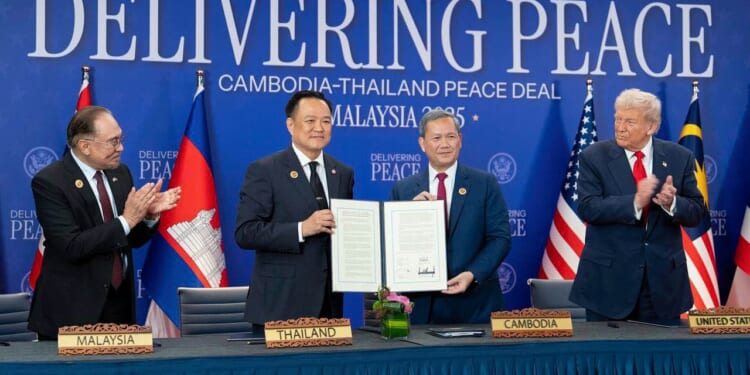Thailand has deployed large numbers of tanks to the border, following a landmine incident on Monday in which four Thai soldiers were seriously injured.
During last month’s Association of Southeast Asian Nations (ASEAN) summit in Malaysia, President Donald Trump loudly and publicly claimed to have ended at least eight conflicts in just eight months, including the Thailand-Cambodia border dispute that resulted in deadly clashes that began in May.
Although Malaysia was the primary negotiator of the peace between the two Southeast Asian countries, Trump threatened to impose steep tariffs on both nations in July if they continued fighting—a step that may have helped force them to the negotiating table. Cambodian Prime Minister Hun Manet publicly praised Trump and the US leader’s “extraordinary statesmanship,” even nominating the 47th president for the Nobel Peace Prize.
However, Trump may have spoken too soon, and Manet’s nomination may have been a bit premature. Earlier this week, the ceasefire deal brokered by Trump collapsed after four Thai soldiers were injured by landmines near the disputed border, with one losing his leg as a result. Thailand’s Prime Minister Anutin Charnvirakul immediately called for the suspension of the peace agreement, even as Cambodia denied it was responsible for the injuries.
The Telegraph reported that some Cambodian officials have suggested that the mines were laid during past conflicts dating back to the 1970s and 1980s, “when millions of landmines were laid by warring factions in the region, and when the US also carried out heavy bombing raids during the Vietnam War,” littering the jungles of Southeast Asia with unexploded ordnance. However, the Thai military has claimed the mines included the recent Russian-made PMN-2, precluding the possibility that they had been laid decades earlier—and were placed on the Thai side of the border.
Thailand Has Deployed Ukrainian-Made Tanks to the Border
On Tuesday, it was also reported that Thailand has once again deployed tanks and artillery to the border region. This is likely to be the largest military buildup since July, when Bangkok ordered its Ukrainian-made T-84 Oplot main battle tanks (MBTs) to carry out assaults on Cambodian military positions. It marked the first recorded combat use of the tanks by the Thai military.
The T-84 Oplot was developed following the dissolution of the Soviet Union in 1991. It is a modernized variant of the Soviet-designed T-80U, equipped with a new turret, armored ammunition compartment, and a diesel engine.
The Oplot MBT has been described as being vastly superior to the T-80U, but Kyiv had only a handful in service when Russia launched its unprovoked invasion in February 2022. The MBTs were too expensive for cash-strapped Ukraine to field in large numbers, so instead, the T-84 was built for export. In 2019, Bangkok acquired around 50 Oplot-M models to replace its aging M41A3 Walker Bulldog light tanks, which dated back to the Vietnam War.
The tanks supplied to the Thai military were outfitted with a different radio and an air conditioner, better suited to the humid conditions in Thailand, rather than a more robust heater more appropriate to the battlefields in eastern Ukraine.
Is the Thailand-Cambodia Conflict Turning into a Proxy War?
A full-blown conflict between Thailand and Cambodia is unlikely, but it could be worrisome. Although Thailand has a significantly larger population and a larger military and is a long-time ally of the United States, Cambodia has close ties to China. Even as Beijing has made clear that it does not seek involvement in the conflict and urged diplomacy, it could still provide materiel aid to Phnom Penh.
That likely would not be enough to tip the balance in Cambodia’s favor, but it could ensure that Thailand won’t secure a quick or easy victory. That is something the French learned in Vietnam, followed by the Americans.
“Terrain favors access from Cambodian territory to the disputed area,” Hawaii-based military analyst Carl Schuster, a former director of operations at the US Pacific Command’s Joint Intelligence Center, told CNN.
“The Royal Thai Air Force is superior and their special forces are superior,” Schuster added. “I think the Thais will prefer to emphasize air power and long-range firepower in the conflict.”
About the Author: Peter Suciu
Peter Suciu has contributed over 3,200 published pieces to more than four dozen magazines and websites over a 30-year career in journalism. He regularly writes about military hardware, firearms history, cybersecurity, politics, and international affairs. Peter is also a contributing writer for Forbes and Clearance Jobs. He is based in Michigan. You can follow him on Twitter: @PeterSuciu. You can email the author: [email protected].
Image: Shutterstock / Prachaya Roekdeethaweesab.

















